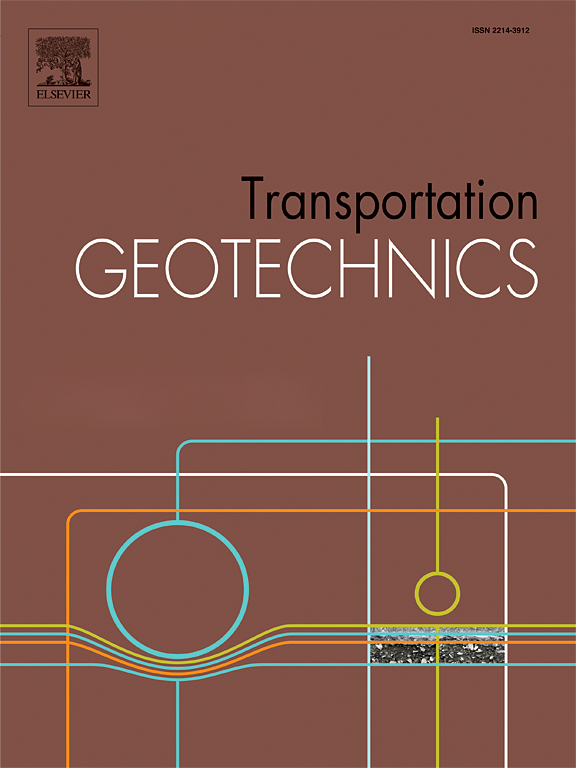Visualization of the microscopic mechanism of slurry infiltration and filter cake formation for slurry shield tunneling in saturated sand: A microfluidic chip experiment
IF 4.9
2区 工程技术
Q1 ENGINEERING, CIVIL
引用次数: 0
Abstract
This study investigated the effects of slurry concentration and pressure on the micro-mechanisms of the slurry infiltration and filter cake formation through microfluidic chip experiments. The formation process of the clogging skeletons and filter cake was revealed. The formation time of clogging skeletons, particle deposition area, average clogging depth and clogging frequency were measured to evaluate the effects of slurry concentration and pressure. The results show that the bentonite particles can clog the pores through the effects of sieving and bridging, thereby forming weakly-permeable clogging skeletons. Subsequent particles deposit on the clogging skeletons and the filter cake begins to form. Higher slurry concentration can accelerate the clogging skeleton formation and enhances its stability. Increasing the concentration from 30 g/l to 60 g/l can increase the frequency of bridging-induced clogging by 2.66 %, leading to a 26 % decrease in the average clogging depth. The shallower clogging depth facilitates a larger external deposition area, significantly reducing the filter cake permeability. Higher slurry pressure can also accelerate the clogging skeleton formation and compacts the external deposited particles. Increasing the initial pressure from 30 kPa to 50 kPa can decrease the frequency of bridging-induced clogging by 2.41 % and increase the average clogging depth by 13 %, which induces the larger internal deposition area and lower filter cake permeability. Considering the effects of the cutter tool penetration depth and rotation frequency on the filter cake, it is recommended the concentration and excess pressure of the slurry used in the engineering applications should not be less than 60 g/l and 50 kPa, respectively.
饱和砂中浆体盾构隧道浆体入渗及滤饼形成的微观机制可视化:微流控芯片实验
本研究通过微流控芯片实验,研究了料浆浓度和压力对料浆渗透和滤饼形成的微观机制的影响。揭示了堵塞骨架和滤饼的形成过程。通过测量堵塞骨架形成时间、颗粒沉积面积、平均堵塞深度和堵塞频率,评价浆液浓度和压力对堵塞骨架形成的影响。结果表明:膨润土颗粒可通过筛分和桥接作用堵塞孔隙,形成弱渗透的堵塞骨架;随后的颗粒沉积在堵塞的骨架上,过滤饼开始形成。较高的浆液浓度可以加速堵塞骨架的形成,增强其稳定性。当浓度从30 g/l增加到60 g/l时,桥接引起的堵塞频率增加2.66%,导致平均堵塞深度下降26%。较浅的堵塞深度有利于较大的外部沉积面积,显著降低滤饼的渗透率。较高的料浆压力也能加速堵塞骨架的形成,并使外部沉积的颗粒压实。将初始压力从30 kPa提高到50 kPa,可使桥接堵塞频率降低2.41%,平均堵塞深度增加13%,导致内部沉积面积增大,滤饼渗透率降低。考虑刀具穿透深度和旋转频率对滤饼的影响,建议工程应用中使用的料浆浓度不小于60 g/l,超压不小于50 kPa。
本文章由计算机程序翻译,如有差异,请以英文原文为准。
求助全文
约1分钟内获得全文
求助全文
来源期刊

Transportation Geotechnics
Social Sciences-Transportation
CiteScore
8.10
自引率
11.30%
发文量
194
审稿时长
51 days
期刊介绍:
Transportation Geotechnics is a journal dedicated to publishing high-quality, theoretical, and applied papers that cover all facets of geotechnics for transportation infrastructure such as roads, highways, railways, underground railways, airfields, and waterways. The journal places a special emphasis on case studies that present original work relevant to the sustainable construction of transportation infrastructure. The scope of topics it addresses includes the geotechnical properties of geomaterials for sustainable and rational design and construction, the behavior of compacted and stabilized geomaterials, the use of geosynthetics and reinforcement in constructed layers and interlayers, ground improvement and slope stability for transportation infrastructures, compaction technology and management, maintenance technology, the impact of climate, embankments for highways and high-speed trains, transition zones, dredging, underwater geotechnics for infrastructure purposes, and the modeling of multi-layered structures and supporting ground under dynamic and repeated loads.
 求助内容:
求助内容: 应助结果提醒方式:
应助结果提醒方式:


